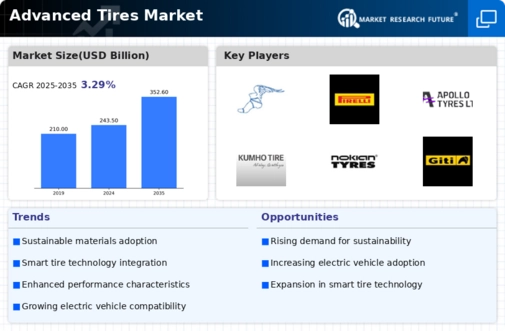Market Trends
Key Emerging Trends in the Advanced Tires Market
The industry landscape is continuously shaped by environmental concerns and technology breakthroughs, causing a substantial shift in market trends within the Advanced Tires sector. Advanced tires, sometimes called smart or intelligent tires, are becoming increasingly popular because of their capacity to increase overall safety, fuel efficiency, and vehicle performance. The increasing integration of sensor technologies is one significant development in the advanced tire market. These tires have sensors that track several variables in real-time, including temperature, tread wear, and tire pressure. In addition to giving drivers vital maintenance information, the data these sensors gather also enables predictive analysis, which lowers the possibility of unplanned tire failures. This pattern aligns with the larger shift towards intelligence in the automotive sector. An additional significant trend is the growing focus on sustainability. As environmental awareness grows in importance, tire producers are concentrating on creating cutting-edge tires using environmentally friendly components and production techniques. This covers the application of bio-based, recycled, and energy-efficient production techniques. The move toward sustainability satisfies legal demands for cleaner and greener automotive technologies and the growing consumer demand for environmentally conscious products. The market trends for advanced tires are also being impacted by the increase in electric vehicles (EVs). Tire producers are adjusting by creating tires specifically tailored to the needs of electric vehicles (EVs). With these tires, the electric vehicle range is intended to be increased, rolling resistance is optimized, and energy efficiency is enhanced. As the adoption of electric vehicles soars across the globe's automotive sector, the market for innovative tires is lining up to be a key component of the sustainable mobility ecosystem. Furthermore, the advanced tire market dynamics are being shaped by the idea of autonomous or self-driving cars. The development of tires that can interface with the vehicle's control system is receiving more attention as driverless vehicles become more commonplace. These smart tires can improve performance and safety by giving the car's autonomous driving system feedback in real-time. The auto industry's dedication to delivering a safe and smooth driving experience is demonstrated using cutting-edge tire technology. Along with these technological developments, industry participants are forming strategic alliances and collaborations to increase their market share. The market trends in the Advanced Tires sector show how quickly this dynamic business is changing to meet shifting consumer wants, shifting regulatory environments, and expanding technology capabilities.

















Leave a Comment